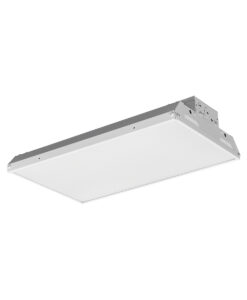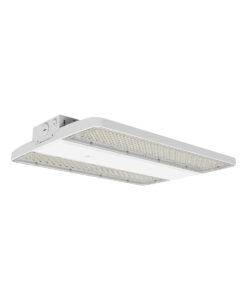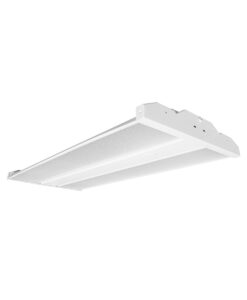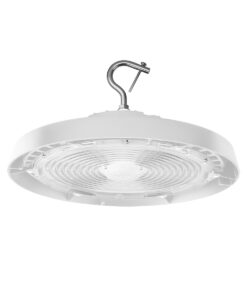Lighting plays a pivotal role in shaping workplace productivity. At PacLights, we’ve seen firsthand how efficient commercial lighting can transform work environments and boost employee performance.
In this post, we’ll explore the science behind lighting’s impact on cognitive function and share practical strategies for implementing effective lighting solutions in various commercial settings. Get ready to illuminate your path to increased productivity and success.
How Lighting Affects Workplace Performance
The Science of Lighting and Cognitive Function
Lighting wields significant influence over workplace performance. Research demonstrates a direct link between illumination and cognitive abilities. A National Bureau of Economic Research study revealed that LED lighting retrofits increased productivity by 0.7, substantially enhancing profits. This performance boost correlates with light’s impact on circadian rhythms and overall alertness.

LED lights with cooler color temperatures (4000K to 5000K) effectively mimic daylight. These temperatures reduce eye strain and improve concentration compared to traditional lighting options. This proves especially valuable in task-heavy areas like workstations and meeting rooms, where a stimulating atmosphere enhances alertness.
Measurable Productivity Gains
The impact of improved lighting on productivity translates to concrete, quantifiable benefits. In warehouses and industrial settings, LED lighting significantly enhances visibility and accuracy, leading to faster work speeds and fewer errors. This improvement reduces costs associated with customer returns, refunds, and expedited shipments due to mispicks.
Optimal Work Environment Creation
Proper lighting transcends mere illumination – it fosters an environment conducive to productivity. Employees exposed to natural light report higher happiness and productivity levels. When natural light isn’t available, LED lighting systems (which closely mimic natural light) can be fine-tuned to meet specific workplace needs.
LED lighting offers an additional thermal benefit, resulting in lower ambient temperatures. This contributes to higher employee comfort and productivity, particularly in industrial settings where heat from traditional lighting fixtures often creates uncomfortable working conditions.
The Financial Impact of Lighting Upgrades
Lighting upgrades can yield substantial returns on investment. This rapid payback period makes lighting upgrades an attractive option for businesses aiming to improve their bottom line.
When considering lighting upgrades, partnering with experts who provide tailored solutions proves invaluable. Some lighting companies offer free lighting layout designs and ROI assessments, helping businesses make informed decisions about their lighting investments.
Understanding the profound impact of lighting on workplace performance empowers businesses to make strategic decisions. These choices not only improve productivity but also contribute to employee well-being and overall operational efficiency. The next section will explore various types of commercial lighting solutions designed to maximize these benefits across different work environments.
Choosing the Right Commercial Lighting Solutions
Illuminating Industrial Spaces
LED high bay lights stand out as the premier choice for warehouses and industrial facilities. These powerful fixtures provide broad, uniform illumination for large, open areas with high ceilings. They reduce shadows and glare, which improves worker safety and productivity in these environments.

LED high bays offer significant energy savings compared to traditional metal halide or fluorescent options. A 150W LED high bay can replace a 400W metal halide fixture while providing better light quality and distribution. This translates to lower energy bills and reduced maintenance costs due to the longer lifespan of LED technology.
Optimizing Office Environments
Troffers and flat panel lights excel in office settings. These fixtures provide even, glare-free illumination that’s ideal for computer work and other detail-oriented tasks. Modern LED troffers and panels offer superior light quality compared to older fluorescent models, which reduces eye strain and improves overall comfort.
Many businesses opt for tunable white light in their office spaces. This technology allows for adjustment of color temperature throughout the day, mimicking natural light patterns. Studies show that this can improve employee alertness and productivity, especially during afternoon hours when energy levels typically dip.
Enhancing Retail Spaces
Linear strip lights prove excellent for retail environments. These versatile fixtures can serve for general lighting, accent lighting, or to highlight specific product areas. LED strip lights provide crisp, clear illumination that accurately renders colors, making merchandise more appealing to customers.
Retail lighting strategies often incorporate a mix of ambient, accent, and task lighting to create an inviting atmosphere and guide customers through the space. Brighter lighting in dressing rooms and at checkout counters can improve the customer experience and potentially boost sales.
Smart Lighting Systems
Smart lighting systems with sensors and controls gain popularity across all commercial sectors. These systems offer a wide range of advantages, including substantial energy savings, cost reductions, enhanced flexibility, productivity, and security.
Smart lighting allows for granular control over different areas of a space. In an office, you might set conference rooms to have brighter, cooler light to promote alertness during meetings, while break areas could have warmer, dimmer light for relaxation.
The careful selection of the right lighting solutions for each area of your commercial space creates an environment that not only looks great but also supports productivity, comfort, and energy efficiency. The next section will explore strategies to implement these efficient lighting solutions effectively.
How to Implement Efficient Lighting Strategies
Conduct a Comprehensive Lighting Audit
Start with a thorough lighting audit of your facility. This process involves an assessment of your current lighting infrastructure, identification of improvement areas, and measurement of light levels throughout the space. Many lighting companies offer free audits as part of their services.

During the audit, focus on areas with inadequate lighting, excessive glare, or outdated fixtures. Take note of spaces where employees report eye strain or difficulty seeing their work. This information will guide your lighting upgrade decisions.
Select the Optimal Color Temperature
The right color temperature creates a productive environment. For most office spaces, a color temperature between 3500K and 5000K works well. This range mimics natural daylight and helps maintain alertness throughout the day.
Consider warmer color temperatures (around 2700K to 3000K) in areas where relaxation is important, such as break rooms or reception areas. For industrial spaces that require high visual acuity, cooler temperatures of 5000K to 6500K often work best.
Maximize Natural Light Integration
Natural light integration can significantly boost productivity and employee well-being. A study by the World Green Building Council found that employees with access to natural light reported a 15% higher productivity rate.
To maximize natural light, rearrange workspaces to place desks near windows. Install light shelves or reflective surfaces to bounce daylight deeper into the space. For areas without direct access to windows, consider skylights or light tubes to bring in natural illumination.
When natural light isn’t available, use LED fixtures that adjust their color temperature throughout the day to mimic natural light patterns. This approach supports employees’ circadian rhythms and can improve overall well-being.
Implement Strategic Task Lighting
Task lighting enhances productivity for detail-oriented work. It provides focused illumination where it’s needed most, which reduces eye strain and improves accuracy.
Add adjustable desk lamps or under-cabinet lighting for workstations. In industrial settings, movable LED work lights can provide intense, focused illumination for intricate tasks or equipment maintenance.
Leverage Advanced Lighting Controls
Lighting controls and automation can dramatically improve energy efficiency while maintaining optimal light levels. Occupancy sensors reduce energy waste by automatically turning off lights in unoccupied areas. Occupancy sensors increase lighting energy savings by turning off or turning down the lights when rooms are unoccupied. Lighting energy savings can range from 10% to 90% depending on the application.
Daylight harvesting systems adjust artificial light levels based on available natural light, maintaining consistent illumination while minimizing energy use. These systems can reduce lighting energy consumption by 20% to 60% (depending on the space and available daylight).
Networked lighting control systems offer the most comprehensive solution, allowing for granular control over individual fixtures or zones. These systems can adjust light levels and color temperature throughout the day, optimizing the lighting environment for different tasks and times.
Work with experienced lighting professionals who can tailor solutions to your specific needs. Some companies offer free lighting layout designs and ROI assessments, which help you make informed decisions about your lighting investments. With a well-designed LED lighting system, operators can create a more productive, safe, and energy-efficient workspace.
Efficient commercial lighting forms the foundation of workplace productivity and employee well-being. Research proves that well-designed lighting solutions boost productivity, reduce errors, and create more comfortable workspaces. The implementation of effective lighting strategies starts with a comprehensive audit of the current setup, which guides decision-making for upgrades.

Selecting the right color temperature, maximizing natural light, and incorporating task lighting create an optimal lighting environment. Advanced lighting controls and automation enhance energy efficiency and allow for customized lighting scenarios. Investing in quality lighting solutions offers long-term benefits beyond energy savings, including improved employee productivity, reduced absenteeism, and enhanced workplace safety.
At PacLights, we understand the critical role of efficient commercial lighting in creating productive workspaces. Our range of LED lighting solutions meets the diverse needs of commercial and industrial facilities. We offer free lighting layout designs and ROI assessments to help businesses make informed decisions about their lighting investments.






Disclaimer: PacLights is not responsible for any actions taken based on the suggestions and information provided in this article, and readers should consult local building and electrical codes for proper guidance.